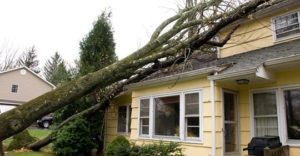
Severe weather can pop up in your neighborhood quickly. If severe weather strikes, your first priority should be taking cover and protecting your family. Unfortunately, the damage after severe weather can wreak havoc on your home and neighborhood. Common types of storm damage to your home can be caused by wind, water, or hail.
After the skies clear and you’ve been given the all clear by your local weather service, checking your home for damage should be your next priority. Protecting your home from further damage is critical. Here are some areas you should inspect.
- Roof. Depending on the storm, roof damage can be significant. High winds can easily tear your shingles off. From the ground, look for missing shingles. If hail came through your area, depending on the size of the hailstones and other conditions, the damage may or may not be significant. Contact your insurance company. They will send out an expert who will be able to identify if you have damage.
- Siding. Depending on your siding, damage may be evident. Brick, stucco, and cement fiber siding are more durable than vinyl siding. No matter what siding type you have, walk around your home and check for damage. Damage can consist of cracks, chips, dents, and holes.
- Outdoor structures. If you have a detached garage or shed don’t forget about them: especially if you’re storing tools, collector cars, or other types of equipment. Even a small hole or leak can damage what’s inside. If you find a hole, consider covering it with a tarp. If that isn’t possible, consider moving those items to prevent further damage. To learn if your outdoor structure is adequately insured, click here.
- Electronics. A lightning strike or power surge can damage or destroy your expensive electronics.
- Fallen trees or limbs. Understanding coverage for fallen trees can be a bit tricky. Do you have coverage for the tree itself, debris removal, or coverage for your neighbor’s fallen tree on your property? Contact your agent to find out.
- Miscellaneous property.Other items to look at include:
- Air-conditioning unit;
- Fence;
- Patio/deck furniture; and
- Cars parked in your driveway.
- Basement. Significant rainfall can be difficult on your sump pump and local sewer system. Check the area around your sump and floor drain. To learn how to keep your sump pump in good working order click here. If you don’t have water backup or sump pump overflow coverage on your policy, talk to your independent insurance agent to learn more.
Miscellaneous Safety Tips
- If you have overhead powerlines in your neighborhood, be cautious when inspecting your property. High wind or trees could have knocked them down.
- Keep your kids out of flooded streets and rushing water. Dangerous situations that weren’t there before may now be present.
- Only consume food or water that was not damaged by the storm.
- If your home has been damaged, consider turning off your main utilities, including your natural gas, electricity, and water main.
- Before a severe storm hits, consider documenting your possessions. Whether you rent an apartment or own a home, one of the most important things you can do is to keep an inventory of your personal belongings. Trying to remember what you own after a disaster strikes can be overwhelming.
Give us a call at 262-728-2631 if you have questions regarding your insurance coverage or need to report a claim.
By Scott Steuber, West Bend Insurance
https://www.thesilverlining.com/westbendcares/blog/what-type-of-damage-to-look-for-after-a-storm-goes-through-your-neighborhood-infographic